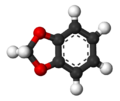| |||
| Names | |||
|---|---|---|---|
| Preferred IUPAC name 2H-1,3-Benzodioxole | |||
| Other names 1,3-Benzodioxole Benzo[d][1,3]dioxole 1,2-[Methylenebis(oxy)]benzene 1,2-Methylenedioxybenzene | |||
| Identifiers | |||
3D model (JSmol) | |||
| 115506 | |||
| ChEBI | |||
| ChemSpider | |||
| ECHA InfoCard | 100.005.448 | ||
| EC Number |
| ||
| MeSH | 1,3-Benzodioxole | ||
PubChem CID | |||
| RTECS number |
| ||
| UNII | |||
| UN number | 1993 | ||
CompTox Dashboard (EPA) | |||
| |||
| |||
| Properties | |||
| C7H6O2 | |||
| Molar mass | 122.123 g·mol−1 | ||
| Density | 1.064 g cm−3 | ||
| Boiling point | 172–173 °C (342–343 °F; 445–446 K) | ||
| log P | 2.08 | ||
| Vapor pressure | 1.6 kPa | ||
| Thermochemistry | |||
Std enthalpy of combustion (ΔcH⦵298) | −3.428 MJ mol−1 | ||
| Hazards | |||
| GHS labelling: | |||
 | |||
| Warning | |||
| H302, H332 | |||
| NFPA 704 (fire diamond) | |||
| Flash point | 61 °C (142 °F; 334 K) | ||
Except where otherwise noted, data are given for materials in their standard state (at 25 °C [77 °F], 100 kPa). | |||
1,3-Benzodioxole (1,2-methylenedioxybenzene) is an organic compound with the formula C6H4O2CH2. The compound is classified as benzene derivative and a heterocyclic compound containing the methylenedioxy functional group. It is a colorless liquid.
Contents
Although benzodioxole is not particularly important, many related compounds containing the methylenedioxyphenyl group are bioactive, and thus are found in pesticides and pharmaceuticals. [1]


